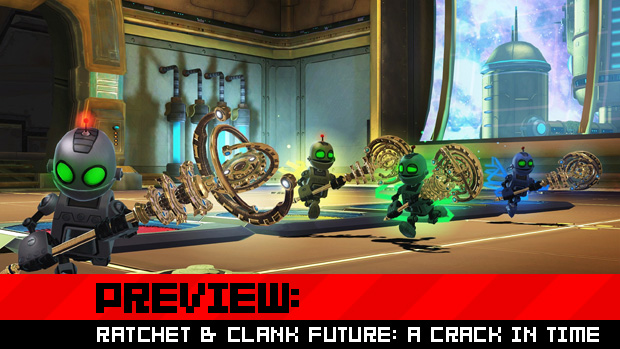It’s only recently that I’ve even begun to play the Ratchet & Clank series of games, having started with the last full-retail release, Tools of Destruction. Why it took so long for me to get around to it is probably chalked up to years and years of notable platforming protagonists wearing me down. I feel as though I really missed out on something with the series, as it’s one of the most charming and genuinely humorous series of platform games I’ve played in a long time.
So it was, armed with my newfound love of the Lombax and his robot pal, that I had an opportunity to sit down at E3 and check out what Insomniac has in store for players in the next iteration of the game. I got to see a little Ratchet, a whole lot of Clank and some very cool new gameplay. Read on for my impressions.
First, let me say this: This game is really pretty. I’m not even sure what they did. It looks cel-shaded but, at the same time, does not look cel-shaded. When I was watching the gameplay demo, the presenter kept talking about “dynamic shadows” or something being responsible for the look. Call it whatever you want, it pops right off the screen and just looks fantastic.
As one would expect, the core gameplay of the Ratchet & Clank franchise remains largely unchanged. It’s still a 3rd-person platforming adventure with creative and amusing weaponry and an emphasis on collection. In this new title, Ratchet won’t have Clank with him — the primary objective being to reunite the two friends — and will gain equipment which substitutes for abilities the plucky robot provides.
One example of new equipment are Ratchet’s hover boots. These grant a number of powers, including a much appreciated function which allows Ratchet to glide along the ground at high speeds, saving time when you just want to get from one place to another. They are also used to take advantage of boost jumps and other such nonsense but the mere idea of being able to travel at a high rate of speed across vast platforming levels is such a blessing that I can’t even be bothered to think about the other practical applications.

Besides, the real meat of the demonstration comes with a first look at playing the Clank-oriented levels, specifically their time-manipulation puzzles. Why Clank has this ability is something which has yet to be revealed but the mechanics themselves are thoroughly sound and look to provide a bit more thought than your standard 3D platformer brainteaser.
In these puzzles, small platforms exist where Clank can record his actions, reminiscent of Blinx: The Time Sweeper with a little bit less freedom as to when you decide to begin your execution. After you have run around, a simple button press warps you back to the platform where you can then command a copy of Clank to perform the same actions you have just done.
A simple example was demonstrated in which there are two recordable platforms and two buttons which must be held down to open a door. The solution is just a matter of recording one Clank standing on each button, then playing back while you move the original Clank through the now opened door. This seemed fairly droll until Insomniac showed a more complex puzzle featuring four Clank copies, two elevators, buttons locked away behind doors, etc.
It seems as though it could be quickly overwhelming were it not for another great feature. Whereas many games which deal with time-manipulation puzzles will punish the player for a mistake by requiring the entire puzzle be restarted, any of the recording panels can be overwritten at any time, making it fairly easy to correct a simple gaff.
I was excited to play through A Crack in Time just to get the conclusion of the story arc which began in Tools of Destruction and it probably would have been enough for me to simply get more of the same out of the sequel. That Insomniac is pushing some very clever gameplay with puzzles that may actually require me to think a little bit more is fantastic and I’m looking forward to it now more than ever.


